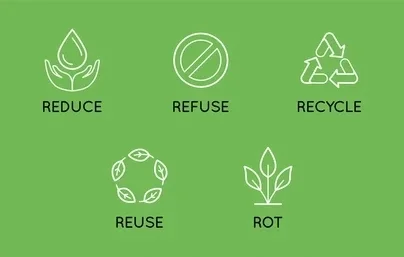Zero waste living is a lifestyle that prioritizes sustainability and reducing waste as much as possible. Here’s the ultimate guide to help you adopt this lifestyle and make a positive impact on the environment.
Waste is a byproduct of human activity that can have a significant impact on the environment, economy, and public health. Waste includes any material that is no longer useful or wanted, including food, plastics, paper, electronics, and hazardous chemicals.
The amount of waste generated by humans has been increasing steadily over time, and it has become a significant global issue. The improper disposal of waste can have a detrimental impact on the environment, causing pollution and other negative effects.
One of the most pressing issues related to waste is the increasing amount of plastic waste in our oceans. This waste can harm marine life and create a major threat to ecosystems. To reduce this impact, governments and organizations are working to improve recycling efforts and reduce the use of single-use plastics.
Another significant issue is the impact of electronic waste or e-waste. As technology advances, more and more electronics are becoming outdated and need to be disposed of. Unfortunately, many of these electronics contain toxic substances that can be harmful to the environment and public health if not disposed of properly. There are now recycling programs and regulations in place to help mitigate the negative effects of e-waste.
Food waste is also a growing issue, as large amounts of food are thrown away each year. This not only wastes resources but also contributes to greenhouse gas emissions as the food decomposes in landfills. Many organizations are working to reduce food waste through education and donation programs.
To address waste-related issues, individuals, organizations, and governments can take a variety of steps. This includes improving recycling and composting efforts, reducing the use of single-use plastics, promoting sustainable production and consumption practices, and enforcing regulations around waste disposal. By taking action to reduce waste, we can protect the environment and promote a more sustainable future.
The Ultimate Guide to Zero Waste Living

It’s important to understand what are pits. Pits are organic waste such as fruit peels and vegetable scraps that can be composted to create nutrient-rich soil for plants. By composting pits, you can divert them from landfills where they would produce harmful greenhouse gases.
In addition to composting, modern recycling Victor MT, make it easier to recycle a wide range of materials. They use advanced technologies to sort and process materials like plastic, paper, and metals, ensuring they are recycled efficiently.
If you’re a coffee lover who uses Nespresso pods, don’t worry about contributing to the waste problem. Nespresso offers a pod recycling program called Nespresso pod recycling that allows users to send back their used pods for recycling. This program has been a significant step in reducing the environmental impact of single-use coffee pods.
Read Also: The Importance of Compact Disc Recycling in a Sustainable Future
Remember the phrase “promise like pie crust”? Well, it’s a reminder that promises are only as good as they are kept. Similarly, the key to zero waste living is to commit to it and make it a habit. Small actions like carrying a reusable water bottle, saying no to single-use plastics, and buying secondhand clothes can make a big difference in reducing waste.
Living a zero waste lifestyle requires a commitment to sustainability and reducing waste as much as possible. By composting pits, recycling at modern facilities, taking advantage of recycling programs, and making small changes in our daily habits, we can make a significant impact on the environment. Remember, promises like pie crusts – easily made, easily broken – so it’s important to make a firm commitment to zero waste living and stick to it.
Another important aspect of zero waste living is reducing food waste. Food waste not only wastes resources but also contributes to greenhouse gas emissions. To reduce food waste, plan meals, buy only what you need, and store food properly to make it last longer.
Another way to reduce waste is to buy in bulk and bring your containers. Many grocery stores now offer bulk sections where you can buy items like grains, nuts, and spices in bulk, reducing packaging waste. Bringing your containers also helps to reduce single-use packaging waste.
When it comes to personal care and cleaning products, look for package-free or refillable options. Many stores offer refill stations for products like shampoo and laundry detergent, reducing packaging waste. You can also make your own cleaning products using simple ingredients like vinegar and baking soda.
In addition to reducing waste, zero waste living also encourages conscious consumption. This means considering the entire lifecycle of a product before buying it, from production to disposal. It also means choosing products made from sustainable materials and supporting companies that prioritize sustainability.
Zero waste living is not about perfection but progress. It’s a journey towards reducing waste and living more sustainably. Start small and take it one step at a time. Remember, every small action counts and can make a big impact on the environment.
One way to make zero waste living more accessible is by connecting with others in your community who are also interested in reducing waste. Joining local zero waste groups or attending community events focused on sustainability can provide support and inspiration for your zero waste journey.
Another important aspect of zero waste living is reducing energy consumption. Using energy-efficient light bulbs, turning off electronics when not in use, and using public transportation or carpooling are just a few ways to reduce energy consumption and lower your carbon footprint.
When it comes to fashion, the fast fashion industry is one of the most polluting industries in the world. To reduce waste in this area, consider buying secondhand clothing or investing in high-quality clothing that will last longer. Donating or selling unwanted clothing can also help reduce waste.
Read Also: What Is the Difference between Environmental Science and Ecology? Answered In Details
In the kitchen, choosing reusable containers, utensils, and straws instead of single-use plastics can make a big impact on reducing waste. Additionally, using cloth napkins and dish towels instead of paper products can significantly reduce paper waste.
It’s important to remember that zero waste living is not just an individual effort but a collective one. Pushing for policy changes that support sustainability and holding companies accountable for their environmental impact can make a significant impact in reducing waste and creating a more sustainable future.
Zero waste living is a lifestyle that prioritizes sustainability and reducing waste as much as possible. By reducing food waste, buying in bulk, using package-free and refillable products, and choosing sustainable materials, we can make a positive impact on the environment.
Connecting with others in our community, reducing energy consumption, choosing sustainable fashion, and pushing for policy changes are additional ways to make a collective impact in reducing waste and creating a more sustainable future.
Another important aspect of zero waste living is reducing water waste. Water is a precious resource and conserving it is crucial for a sustainable future. To reduce water waste, consider taking shorter showers, fixing leaks, and installing low-flow toilets and showerheads.
Reducing transportation-related emissions is also an important part of zero waste living. Walking, biking, or taking public transportation instead of driving alone can significantly reduce your carbon footprint. When traveling long distances, consider taking the train instead of flying.
Reducing waste in the workplace is also a crucial part of zero waste living. Encouraging office recycling, reducing paper waste by going digital, and using reusable containers and utensils can all help reduce waste in the workplace.
It’s important to remember that zero waste living is not about depriving oneself of the things we need or enjoy. It’s about finding sustainable ways to meet our needs while reducing waste and minimizing our impact on the environment.
Zero waste living is a holistic approach to sustainability that involves reducing waste and conserving resources in all areas of our lives. By reducing water and energy consumption, reducing transportation-related emissions, reducing waste in the workplace, and finding sustainable ways to meet our needs, we can make a significant impact on the environment. Ultimately, zero waste living is about finding a balance between our needs and the needs of the planet, so that we can all thrive together.
Read Also: Trexis Insurance: Your Reliable Partner in Protection

